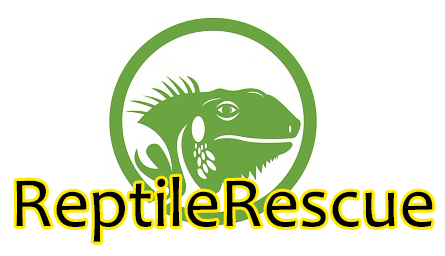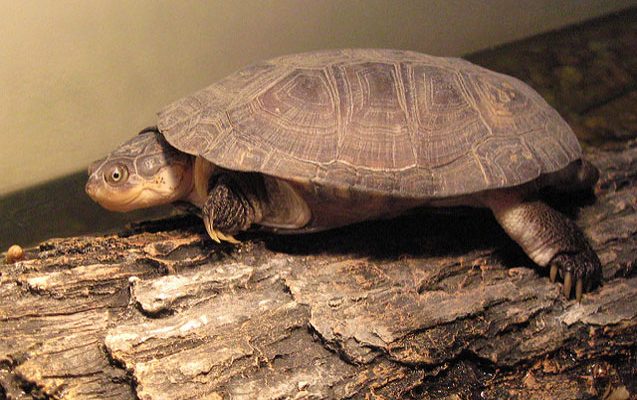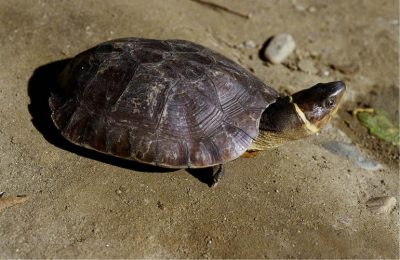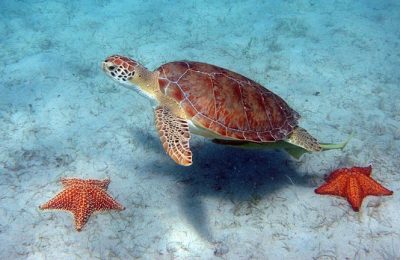Tortoises are lovely creatures of the wild. Some people have domesticated and kept them as pets;…
African Sideneck Turtle
Looking like cousins with the African helmeted turtle, the African Sideneck Turtle, aka African Mud Turtle, attained its name from location and neck disposition. This aquatic species of turtles is unable to withdraw its head into the shell completely, and instead, it parks it to the side. When you look at the African Sideneck turtle with its head tucked to the side, it looks like it is peeking at you.
So what do you know about these species? If you are unfamiliar with the African Sideneck turtle, we have assembled a few facts and tidbits of information that will prove helpful. Before we waste any more time, let us jump right in:
Background
As the name suggests, African Sideneck Turtle is from the African continent, especially the West African region. The species is not only found in West Africa but also Central Africa. The turtle identified by its scientific name Pelusios castaneus is a bit larger than the regular turtles and has a long life span between 25 and 50 years.
This species can attain a carapace length of about 11 inches, but typically, the carapace length ranges between 8-10 inches. This carapace normally turns a dark brown which matches the color of the entire body. When you look at the underbelly, the color varies slightly, looking like a greyish black, but it all ties into the rest of the body to create an attractive appearance.
One thing that is somewhat unique about these turtles is their faces. Their faces feature large and clear round eyes that are hard to look away from. Another distinguishing feature is their permanent smile, as if they are the happiest animals in the world.
These aquatic turtles have longer necks than the average turtles, which gives them an advantage. If you flip the turtle on its shell, it will use its strong ling neck muscles to prop itself back up. In most cases, when you flip a turtle on its shell, it is unable to flip back up.
Temperament
Turtles are laid-back animals, but with the wrong move, you might not find them so friendly. When you socialize with the African Sideneck Turtle, they are a little shy, but the shyness wears off eventually. They are cute, but they do not enjoy handling too much. Handling causes them stress which in turn turns to aggression.
If you don’t watch out, you may end up with a nasty bite. Ensure that you clean your hands after handling the aquatic animals because there is a possibility they have salmonella bacteria on the surface of their body.
Food Preference
Being that the African Sideneck Turtle is omnivorous, they indulge in a wide variety of foods. Apart from vegetation, fruits, and seeds, these animals snack on crabs, earthworms, leeches, snails, fish, and frogs, among many others. Their wide range of food selection sees that they have something to feed on regardless of the season.
You cannot classify African Sideneck Turtles as picky eaters because they enjoy a wide variety of foods. Even as a pet, you should not restrict the diet too much because they get the nutrients they need from different food sources.
While the turtle becomes omnivorous as they grow older, the younger turtles tend to be carnivorous. It is possible to feed these animals beef hearts, cooked chicken, prawns, or aquatic insects as a protein source. If you do not have enough time to do this, there are turtle-friendly treats available in the market.
While proteins are essential, green vegetables are also an excellent source of nutrition. The African Sideneck Turtle can eat collard greens, romaine lettuce, dandelions, spinach, etc. These animals are aquatic; hence they eat in water, leading to a messy tank. You can remedy this by feeding them in a separate area and then transfer them back to the tank.
Juveniles eat on a daily basis while the older ones eat every two or three days.
Suitable Habitat
Where there is water, the African Sideneck Turtle will thrive. This West African Native turtle resides in swamps, rivers, lagoons, ponds, and other aquatic habitats. When the weather gets harsh and things dry up, the animals burrow in mud and stays there until water levels recover.
If you are looking for a pet turtle for this species, the first thing you need is a sizeable aquarium. If you are dealing with a young turtle, get a tank that will contain its size as it grows. Larger-sized African Sideneck Turtles require a larger tank with an estimated 150-175 gallon capacity.
This provides enough room to move about, and the tank should be deep for easier maneuverability by the turtles. Place large rocks to provide basking spots and other decorations like vegetation that could resemble the natural aquatic environment they live in, in the wild.
Among other things that you need to make the aquarium livable are a pump to keep the water fresh and oxygenated and a UVB light that helps them synthesize the vitamin D3. You should install the light next to the basking spot for the best results.
Furthermore, do not forget to regulate the water temperature because the perfect temperature for African Sideneck Turtle is between 70-75 degrees Fahrenheit. Tell your aquarium supplier that you need a turtle aquarium, and they will provide you with all the things you need.
Breeding
The African Sideneck Turtle lays twice a year; they lay and nest the eggs during the dry season, also known as harmattan. They lay several eggs to increase the chances of their hatchlings’ survival.
Once they lay the eggs during the dry season, nature dictates that they hatch during the rainy season. This way, the aquatic animals have enough water to provide adequate food and a stable environment for the hatchlings to grow.
Lurking Predators
Humans are the main predators of the African Sideneck Turtle. In West Africa, people view the animals as a delicacy, and they use their shells and skins for other purposes. These animals are also taken in large numbers and transported as pets around the world. Laying about 18 eggs annually, people have to be careful not to endanger the species.
Health Problems
African Sideneck Turtles are generally healthy if well taken care of; however, there are some treatable ailments that they face. A damaged shell can be a big issue because it’s the turtle’s source of protection. There are medicines that your doctor can prescribe to alleviate this.
Like most aquatic turtles, it is easy for them to get parasites like roundworms. Because the turtle does not show any recognizable symptoms of the parasitic attack, the problem continues to grow until treatment ends up taking a long while. The discovery of such infections is typical when you take the pet to the vet.
If you notice that your African Sideneck Turtle has swollen eyes that produce pus, your pet might be suffering from a deficiency in vitamin A. Aside from that, these turtles are prone to respiratory infections; therefore, it should not be surprising if the turtle starts wheezing.
Eye problems are not uncommon either, dehydrated turtles usually develop this problem, but the doctor can prescribe treatment measures to rectify the situation. If you reside in cold areas, you need UV light to provide the necessary heat to keep the animal in the best condition possible.
Setting up The Aquarium
When looking to set an aquarium for your African Sideneck Turtles, here are a few tips that might be of help. For example,
- You do not need to purchase an expensive aquarium if you do not have money. There are other pocket-friendly ways to ensure your turtle lives in comfort, such as baby pools, custom-built enclosures, and Rubbermaid totes.
- Remember that the deeper the aquarium, the better because the animals have adequate room to swim around without competing for space.
- Using substrate is an option depending on your preference because you are responsible for cleaning the tank. If you choose to use substrate, try large pebbles or gravel that the turtle cannot swallow.
- A pump is essential in keeping the water fresh for a while. Experts recommend that you get a pump with a 350g/h capacity to provide enough power to circulate the water.
- You can add trees or branches into the aquarium; just make sure that they are not high enough for the turtle to use as a launchpad out of the tank.
- Use your lights in conjunction with a digital thermometer to help track if the temperatures are suitable for the animal.
- Replace your UVB lights after every nine months as they tend to lose power over time.
Conclusion
African Sideneck Turtles are not only cute but are relatively easy to care for. They have a long life span; hence they are great as pets. You can get them in most pet shops at an affordable price, but you will spend a bit more to get a befitting aquarium. The good news is once you set up the aquarium, there aren’t many other things to buy, just keep the tank clean, and you are good to go!
If you need a long-term pet, the African Sideneck Turtle is an ideal choice. If you don’t believe us, give it a try and see for yourself.





This Post Has 0 Comments